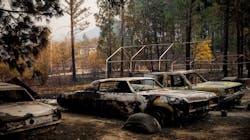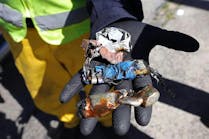Heavy Rain Boosts CA Wildfire Containment
By Kimberly Veklerov
Source San Francisco Chronicle
Nov. 23 -- The first major soaking of the season that swept through Northern California helped boost containment of California’s deadliest wildfire to 95 percent Thursday evening.
Air quality in the Bay Area was mostly “good” — down from “very unhealthy” and “unhealthy” readings just days ago, according to the Environmental Protection Agency’s Air Quality Index.
The rain was welcome for many, but it also left hazards in its wake. Rock and mud slides temporarily closed part of Highway 1 in Big Sur, and roads across the region were slick for Thanksgiving travelers. The National Weather Service said it detected nine lightning strikes between Napa and Yountville.
In Butte County, where the Camp Fire has burned for two weeks, the rate of rainfall Tuesday night and Wednesday was thankfully low, even though showers lasted for a relatively long period, said Craig Shoemaker, a Weather Service meteorologist.
“The real key is intensity,” he said. “It rained for quite a long time, but the intensities weren’t enough to cause flooding.”
Bursts of heavy rain are more likely to cause debris flows, mudslides and other dangers, Shoemaker said. The area got from 1 to 1.7 inches of rain.
The storm minimized fire activity and allowed crews to hold containment lines, officials said. Active firefighting was suspended Thursday in some areas that couldn’t be accessed because of the rain.
“It was very wet and very muddy,” said Fresno fire Capt. Paul Garnier, a spokesman. “The main focus is still on search and recovery.”
Support crews were also hauling back equipment and rolling up hoses out of some areas, Garnier said.
By Wednesday afternoon, “fire activity was almost zero,” said Josh Bischof, an operations chief with the California Department of Forestry and Fire Protection.
Aviva Braun, a National Weather Service meteorologist assigned to the Camp Fire, said there were reports of minor ash flows and mudslides in the unincorporated town of Centerville, near Butte Creek. There were probably rock slides on parts Highway 70 but no eyewitnesses to confirm, because the road was closed, Braun said.
Winds in the fire zone picked up significantly Thursday afternoon. The stronger winds could topple trees already weakened by fire and rain-soaked soil, Braun said.
A flash flood watch and wind advisory were in effect Thursday for the area and were expected to extend until 10 a.m. Friday, said Karl Swanberg, a National Weather Service forecaster.
The Three Peaks campground in Big Sur led the region in rainfall totals, getting 3.9 inches as of Thursday morning, according to the Weather Service. Highway 1 from Ragged Point to Deetjens was closed Wednesday night because of concerns about mudslides but reopened Thursday at 9 a.m., according to the California Department of Transportation.
An additional storm system made landfall Thursday night and was expected to drop steady rain on Northern California through Friday. Showers are forecast to taper off by Saturday morning, and with a foot or more of snow expected to fall above 6,000 feet in the Sierra, according to the Weather Service.
A winter storm warning for the Sierra was in effect until 10 a.m. Friday. Chains were required on both Interstates 80 and 50 Thursday night, with heavy traffic and several spinouts.
Kirkwood Mountain Resort reported getting 11 inches of snow overnight from Wednesday to Thursday. Heavenly Mountain reported 5 inches, and Northstar got 7 inches. Ski resort operations were minimal. Squaw Valley had opened only two of its 175 runs and its cable car was on wind hold, with gusts of up to 80 miles per hour. Heavenly was closed due to high winds.
The burn scar — lands charred by the Camp Fire— could get another 2 to 4 inches, Shoemaker said.
Forecasters said more rain could be on the way. Another storm is expected to arrive Tuesday or Wednesday.
“We’ll see storm systems coming in quite frequently through the end of November and into early December,” Shoemaker said. “Everybody associated with the burn scar, living close by or doing work there needs to be aware that we’re going to be in this active pattern.”
___ (c)2018 the San Francisco Chronicle Visit the San Francisco Chronicle at www.sfgate.com Distributed by Tribune Content Agency, LLC.






